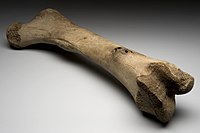
Photo from wikipedia
OBJECTIVES To make direct comparisons of the biomechanical properties of a control (CTL) group and implants that were augmented with far cortical locking (FCL), bone substitute material (BSM), and a… Click to show full abstract
OBJECTIVES To make direct comparisons of the biomechanical properties of a control (CTL) group and implants that were augmented with far cortical locking (FCL), bone substitute material (BSM), and a combination of both (ALL) to determine which fixation is most effective in reducing implant failure. METHODS The constructs were tested with osteopenic cadaveric specimens in a two-part fracture model. Specimens were subjected to a battery of nondestructive torsion and axial compression tests, followed by a cyclic test. Construct stiffness and cycles to failure were documented, pre- and post-test fluoroscopy was performed, and implant and bone kinematics were quantified. RESULTS During nondestructive testing, the BSM group exhibited significantly increased torsional and axial stiffness compared with the FCL (P = 0.006, P < 0.001) group and ALL group (P < 0.001, P = 0.006). There were no significant differences in resistance to cyclic loading between groups. Fluoroscopic analysis indicated significant differences in the motions of nonlocked cannulated screws (used in BSM and ALL) versus locked screws (used in CTL and FCL). CONCLUSIONS Patients with poor bone quality and proximal humerus fracture may necessitate added compliance or rigidity to achieve fixation. Both have exhibited favorable biomechanical characteristics in this cadaveric 2-part proximal humerus fracture model.
Journal Title: Journal of Orthopaedic Trauma
Year Published: 2020
Link to full text (if available)
Share on Social Media: Sign Up to like & get
recommendations!